While in Mexico, we had the opportunity to do a number of different cenote dives. Frequently found on the Yucatan Peninsula, a cenote is a sinkhole leading to an underground body of water. Often the result of a collapsed cave ceiling, the water is usually freshwater and incredibly clear since it’s mostly rain water that has filtered through the ground. There are hundreds of kilometers of underwater passages beneath the Yucatan Peninsula, though only a handful of locations are actively guided and accessible without advanced cave diving certification. Unbelievably, we even found a house with a private cenote right in the middle of Playa del Carmen on 5th Ave. While we couldn’t dive that one, we did feed the pet turtle and catfish.
The first cenote we dove was called ‘The Pit’. An hour drive from Playa del Carmen towards Tulum and then down a rough dirt road into the jungle, you arrive and quickly put on your gear to hide from the mosquitoes. There’s a 2 minute walk to the lip of the cenote which is about 10-15m across, then prepare yourself for an 8 meter drop to the water below. If I were to do this site again, I’d insist on having my gear lowered down by the pulley system, or I’d even throw my gear down separately. Kelly got a nice bruise from a regulator to the nose, and when I jumped in the crotch strap on my BCD was none too kind.
Once you’re in and gear checks are complete you rapidly descend down to 35m where there’s a cloud of hydrogen sulphide separating the freshwater and saltwater halocline. The cloud is created from rotted vegetation and smells of sulpher as you pass through it. At 40m you’re supposed to be below the cloud but it was unbelievably thick with nearly zero visibility on that day, so we weren’t able to find the human bones and pottery shards that are supposed to be laying along the bottom of a crevice.
Just to add some excitement to our near blind adventure, it was then that I realized I was ‘narced’ for the first time. Nitrogen Narcosis is vaguely like being drunk underwater with a feeling of elation, impairment, and numbness. Narcosis generally occurs when diving deeper than 30m and is caused by the increased solubility of the gas you’re breathing at greater depths. There’s no real danger to divers who are narced as long as they’re aware of the situation. Ascending to lesser depths reverses the condition, so I made a ‘drinky-drinky’ motion to Kelly, letting her know I was a little tipsy and we started to climb back above the acid cloud. Still, it was an interesting minute or two trying to determine which way was up and out in near zero visibility while my head spun round and round. :)
Emerging from the cloud, looking up, you’ll see the most amazing rays of sunshine filtering down from above. We rejoined our group and did a multi-tiered ascent, exploring the various cave pockets, tree roots, and stalactites. After a safety stop, we surfaced, attached our gear to the pulley, then climbed up a section of the wall, back to the lip of the cenote. Whew! That one was quite the adventure.
Our next dive was just a few minutes back along the dirt road at Dos Ojos (Two Eyes). While The Pit is exactly that, a big pit… Dos Ojos is a huge series of interconnected cave systems. Popular with both snorklers, cenote divers, and cave divers there’s a well marked rope system that leads cenote divers through the caves. It’s a significantly shallower dive at around 8-12m as you swim between stalagmites and stalactites, peering back into the dark caves with your flashlight and wondering what might live outside the reaches of it’s beam. It’s spooky, but amazingly beautiful at the same time. Watching the sun filter down as you enter a cavern that opens up above. Swimming through openings carved into the rock over thousands and thousands of years by the slowly moving waters. There’s even these low pitched echoes thrumming through the water. My guess was it was cars passing above us and the sound coming down through the stone. After 45 minutes we were back at the entry point and my teeth were chattering. That freshwater gets cold! I highly recommend a 5mm+ wetsuit if you’ve got one.
A few weeks later we decided to do another day of cenote dives. Our first dive took us to Cenote Angelita (Little Angel), just outside of Tulum. Similar to The Pit, it is a wide, deep, sinkhole descending down to 2 shelves. One at 60m and another at around 35m. After a short walk from the truck, there’s a small jump of a couple meters into the water. We dove down on the side going down to 35m, descending through the hydrogen sulphide cloud. This time we were able to get below and look up at the swirling mists above. And even from above the cloud, there’s an amazingly spooky view of root systems on a little island surrounded by clouds.
Our next dive was at Grand Cenote. Similar to Dos Ojos, it was shallow and through many interconnected cave systems. Good buoyancy and fin control is necessary on these types of dives. One of the other divers was kicking up a lot of silt and we had to wait for it to settle so we could see where we were going. At one point we got into a nice bowl cavern and turned off all our lights, just watching the natural light play in the water.
All in all, we had 4 great dives and I’d highly recommend cenote diving around Tulum, Mexico. They were feature dives for each of us and a really nice change of pace with stunning views to be experienced and captured.
So, if you’re not claustrophobic and are diving Cozumel. Take a day off the reef and head towards Tulum for an underground experience you won’t soon forget. Pack your warmest wetsuit. Don’t forget your torch. Keep an eye out for freshwater cave monsters… and I’m sure you’ll be glad you visited Mexico’s cenotes.
Posted by: Shim
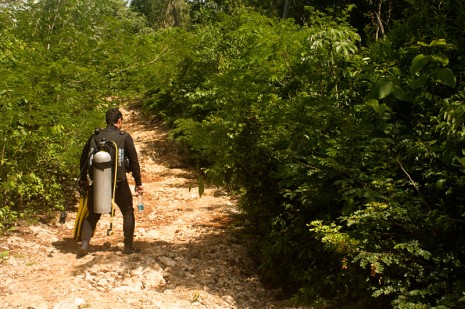
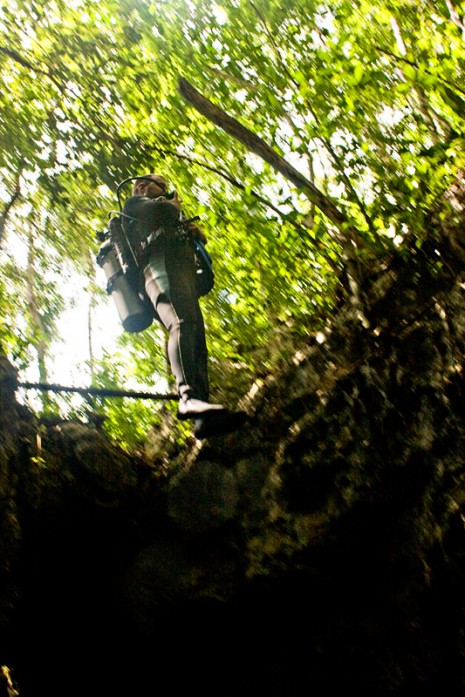
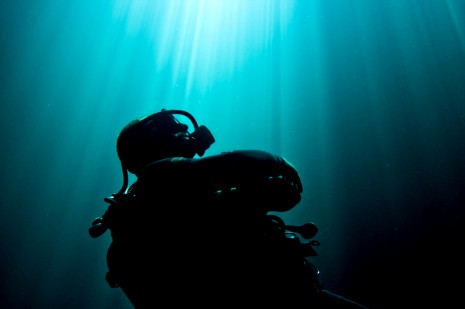
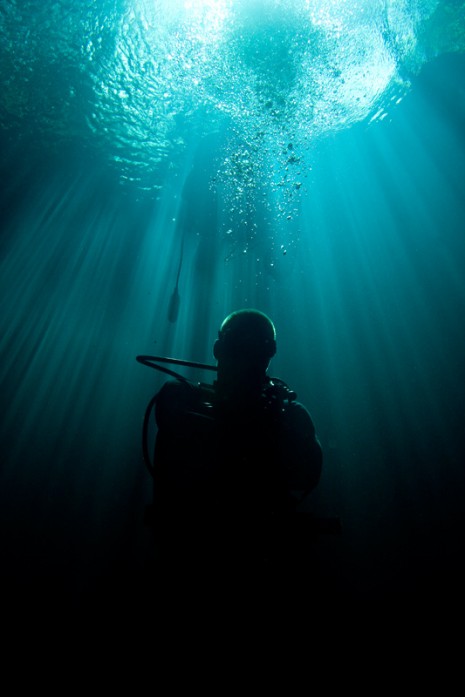
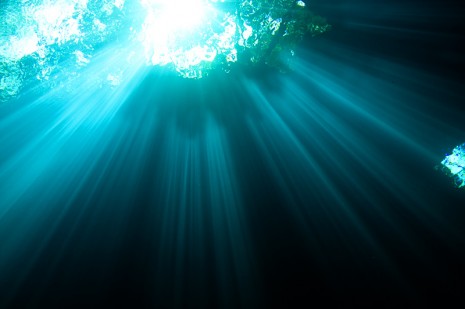
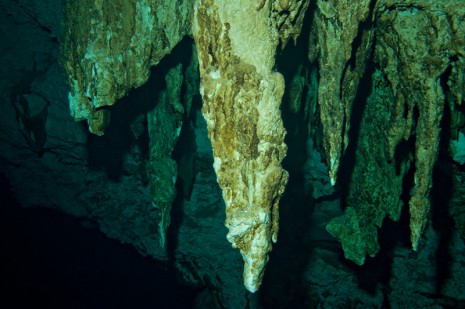
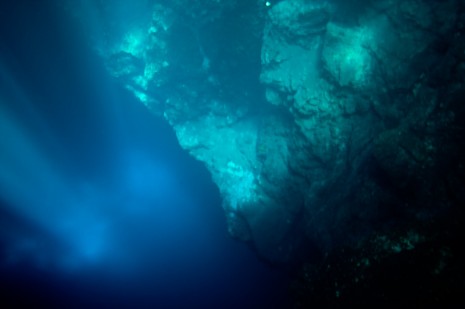
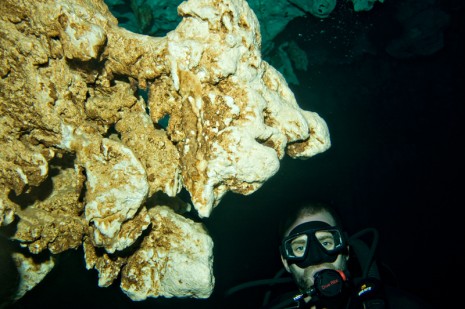
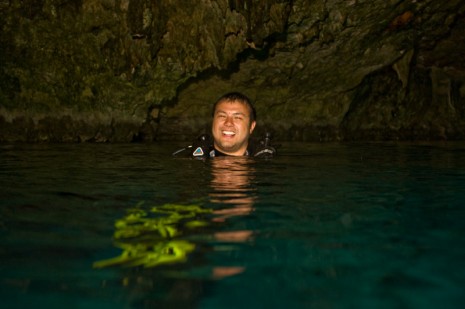








Awesome! I think I know that cave monster in the last photo
Love these photos – absolutely gorgeous!
Wow, your photo’s are amazing! We like to dive but that’s a bit too dark for me.
Amazing! These underwater passages are stunningly beautiful! It must be nice seeing this wonder in person and experience something as thrilling as this!
These are amazing pictures of these underground bodies of water, what a wonderful thing you have experienced.